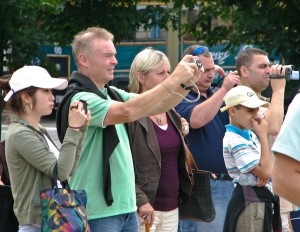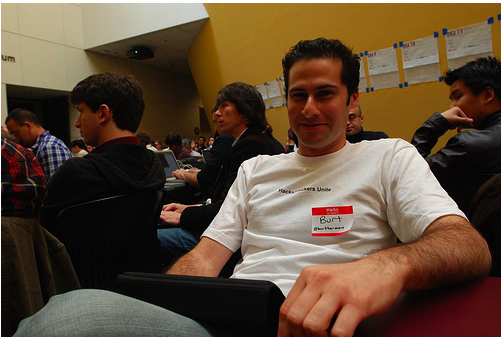Lecture by Jon DeNunzio from The Washington Post
Jon DeNunzio, User Engagement Editor, The Washington Post. (former Online Sports Editor) Follow Jon’s tweets!
DeNunzio came to George Mason University on Mar. 3, 2011; he talking about integrating Social Media Into your journalism.
Background:
- Graduated UVA in 1991
- Was not a journalism major
- Concentrated in high school sports at Washington post 2000-2007
- Got into digital communication to keep a job
One of the biggest highlights of the lecture was when he talked about third party platforms. He asked, “Who is Mashall McLuhan?” He then showed the Annie Hall Youtube video. YOU SHOULD WATCH IT. The just of the video is a quote, “The medium is the message”- McLuhan 1964.
DeNunzio blasted back, “Its not the media, it’s the social.”
And of course, he gave a few websites that as online journalists we should all be aware of. They are:
Filed under Uncategorized | Comments (3)Briggs Chapter 6
Visual Storytelling with Photographs
“The ability to publish to a global audience for free, with just a few clicks, opened up te world to a cacophy of new voices.” –Biggs
So who is considered a photogropher now?:
- You
- Me
- Anyone with a camera
- Anyone with a cell phone camera
There are two primary kinds of cameras, says Briggs. The two are: A point-and-shoot, where it is easier to use and more affordable. Lens and flash are built in. A DSLR camera will capture better photographs because its image sensor is commonly 10 times larger, usually costs two to three times more.
Editing: Like capturing compelling photos, this is a skill that takes thought and consideration to master. If you can, enlist someone else in your photo editing. A cold eye on your photos, with your description of the story, may yield surprising feedback. Or it may simply reinforce what you thought before!
When preparing for online publishing:
- Edit, never use original
- Crop
- Resize
- Modify resolution
- Tone and color correct
- Save a web version
- Keep it simple!
Briggs Chapter 5
Going Mobile: Mobile reporting.
“According to an article in the Daily Telegraph, a London newspaper, children in the United Kingdom get their first mobile phones at age 8” said Briggs.
Anyone one the ground can technically become a reporter at any given time that something newsworthy breaks out in front of them. A child could see a car accident, snap a picture of it, and the picture could end up on twitter, or even the front page of a newspaper the next day.
Briggs explained that there are two ends of the spectrum when using equipment on the field.
Gearhead: A dedicated mojo whose job is to be out and about and report from the field all day, ever day. This person is telling multimedia stories and publishing them from anywhere. Equipment needed- The best and coolest.
Light packer: A more traditional journalist, someone who occasionally needs to report or publish immediately from the field. Equipment needed– Just enough to get the job done.
You will need(compact versions are preferred): Laptop, Internet connection, camera, video camera, tripod, audio recorder, headphones, microphone, and/or cell phone.
Filed under Uncategorized | Comment (0)Skype session with Burt Herman
This is Burt. This is the website he co-founded.
Courtesy of bertherman.com: He is an “Entrepreneurial journalist stoking media revolution. CEO and co-founder of Storify, building the future of journalism. Founder of Hacks/Hackers, bringing together journalists and technologists.”
Great introducation on Burt- now for the BIG news! He skyped with us today from somewhere on the west coast. My guess is Silicon Valley since he is a technology superstar.
He talked about how storify can be a tool to simplify the process of telling a story online. “We have this amazing situation where everyone can be a reporter on the ground” Burt said.
Storify knows that a tweet, is a tweet. A video has certain tags on it. This information is much richer than it would be if you simply just copied and pasted in links.
Professor Steve Klein asked, “How do you stay plugged in? Telling stories is constantly changing becasue of all of these newer online platforms.”
Burt Herman responded with, “I’m hungry to always search new sites out. I get emails everyday from places like mediabistro, mashable; I have tech friends. I do look at twitter, but i do confess, it’s not always a news good source for me. Sharing your idea is the best thing to do. Nobody is going to steal your idea, because they wont care about it as much as you do.” Mark Zuckerberg would.
Filed under Uncategorized | Comments (9)Briggs Chapter 4
Microblogging: Write Small, Think Big
News in 140-characters
The twitter chapter! Basically I’m going to break it down for you in a few basic points.
Real-time uses of Twitter:
- Evacuations
- Tradgedy
- Trial Coverage
- Broadcast news
Start using Twitter, Tweet!
- Establish your goal
- Have a topic
- Make a network
- Perhaps build personal brand
Twitter lingo-
DM: Direct message
@: For a reply, it precedes a Twitter ID in a reply. Are you reading this? Tweet me a reply! @Lyndseymercier
Tweet: send a message on Twitter
RT: Retweet, copying someone tweet, and posting it so your followers can see it.
Hashtag: Common label for a twwet that should be tied together with others’ tweets, preceeded by a # symbol.
What is there to do on Twitter?
- Post
- Read
- Reply
- Direct message
Filed under "Journalism Next" | Comment (0)




